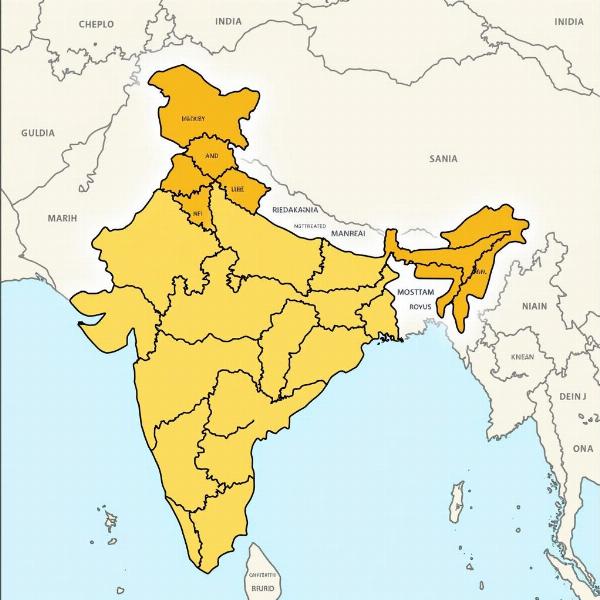Understanding the phrase “all over India” is crucial for anyone navigating the diverse linguistic landscape of the country. This phrase, commonly used in English, signifies something that is widespread or prevalent throughout the entire Indian subcontinent. Knowing its Hindi equivalents allows for clearer communication and deeper cultural understanding. This article explores various ways to express “all over India” in Hindi, considering regional variations and contextual nuances.
Exploring Hindi Equivalents for “All Over India”
The most common and straightforward translation of “all over India” in Hindi is “पूरे भारत में” (pure Bharat mein). This phrase literally translates to “in whole India” and is widely understood across the country. However, depending on the context and the desired emphasis, several other options exist.
- समूचे भारत में (samooche Bharat mein): This option carries a more formal and literary tone, emphasizing the entirety of India.
- सारे भारत में (saare Bharat mein): Similar to “pure Bharat mein,” this phrase is commonly used in everyday conversation.
- भारत भर में (Bharat bhar mein): This phrase emphasizes the widespread nature of something across India.
- देश भर में (desh bhar mein): While “desh” generally translates to “country,” in the Indian context, it often refers to India. This option is a more colloquial and widely used alternative.
 Map of India Highlighting its Vastness
Map of India Highlighting its Vastness
Regional Variations and Contextual Nuances
While the above translations are generally understood across India, regional variations in Hindi can influence the preferred phrasing. For instance, in some regions, “pure Bharat mein” might be more common, while in others, “desh bhar mein” might be preferred. The specific context also plays a crucial role. If you are discussing a cultural practice prevalent throughout India, “samooche Bharat mein” might be a suitable choice. For a more general statement about something found across the country, “Bharat bhar mein” or “desh bhar mein” could be more appropriate.
Choosing the Right Hindi Equivalent
Selecting the most appropriate Hindi translation depends on various factors, including the audience, the formality of the situation, and the specific nuance you wish to convey. Consider these examples:
- Formal context: “The new policy will be implemented samooche Bharat mein.”
- Informal context: “You can find this type of street food desh bhar mein.”
- Emphasis on widespread nature: “This festival is celebrated Bharat bhar mein with great enthusiasm.”
Understanding the User Intent Behind “All Over India Meaning in Hindi”
Users searching for “all over India meaning in Hindi” likely seek to communicate effectively in Hindi or understand Hindi content that uses this expression. They may be translating documents, preparing presentations, or simply trying to enhance their language skills. Understanding this user intent allows us to provide accurate and relevant information.
Why is Knowing the Hindi Equivalent Important?
Knowing the Hindi equivalent of “all over India” is essential for seamless communication and cultural sensitivity. It demonstrates respect for the local language and facilitates better understanding, particularly when interacting with Hindi speakers.
Conclusion
Knowing how to express “all over India” in Hindi enhances communication and demonstrates cultural sensitivity. While “pure Bharat mein” serves as a standard translation, understanding the nuances of other options like “samooche Bharat mein,” “saare Bharat mein,” “Bharat bhar mein,” and “desh bhar mein” allows for more precise and contextually appropriate communication. By choosing the right phrase, you can ensure your message resonates effectively with your Hindi-speaking audience.
FAQ
-
What is the most common Hindi translation for “all over India”?
The most common translation is “पूरे भारत में” (pure Bharat mein). -
Are there any regional variations in the Hindi translation?
Yes, regional preferences might exist, with some regions favoring “pure Bharat mein” while others prefer “desh bhar mein.” -
When should I use “samooche Bharat mein”?
This phrase is suitable for formal contexts and emphasizes the entirety of India. -
Is “desh bhar mein” an acceptable translation?
Yes, “desh bhar mein” is a colloquial and widely accepted translation, often used in everyday conversations. -
Why is knowing the Hindi equivalent important?
It facilitates clear communication, demonstrates respect for the local language, and enhances cultural understanding.
Meaning-Hindi.in: Your Trusted Partner for Hindi Translation Services
Meaning-Hindi.in provides expert Hindi translation services for diverse needs, from business and legal documents to technical manuals and website localization. We specialize in accurate and culturally sensitive translations, ensuring your message resonates effectively with your target audience. Our team of experienced translators understands the nuances of both Hindi and English, delivering high-quality translations that meet your specific requirements. Contact us today for all your Hindi translation needs! Email: [email protected], Phone: +91 11-4502-7584. Let Meaning-Hindi.in bridge the language gap for you.